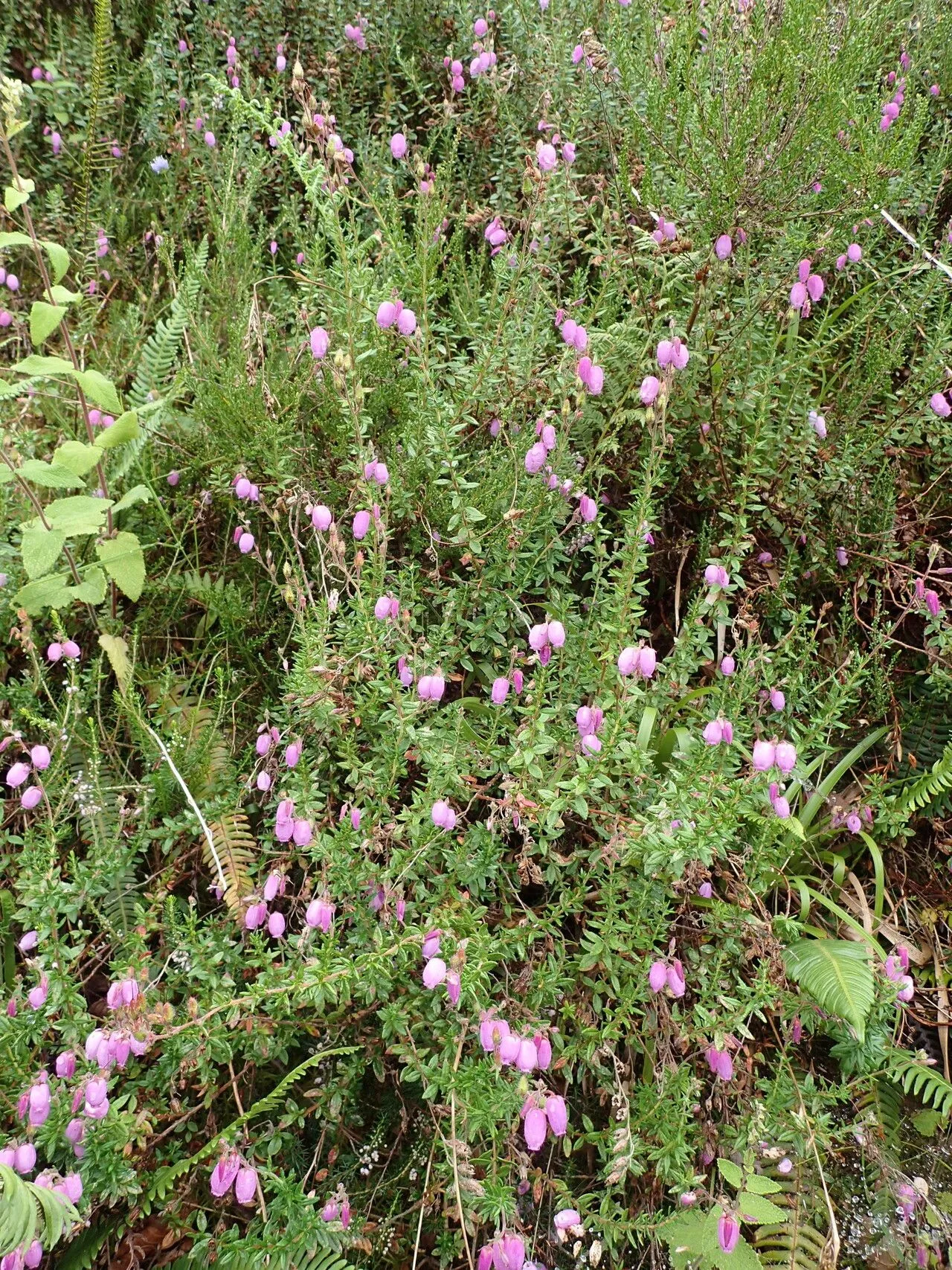
Author: (Huds.) K.Koch
Bibliography: Dendrologie 2(2): 13 (1873)
Year: 1873
Status: accepted
Rank: species
Genus: Daboecia
Vegetable: False
Observations: W. Ireland, W. France to NW. Portugal
St. dabeoc’s-heath, scientifically recognized as Daboecia cantabrica, is a perennial evergreen shrub that belongs to the Ericaceae family. This captivating plant, named to honor St. Dabheog, thrives in specific geographical locations including Western Ireland, Western France, and Northwestern Portugal, reflecting its adaptability to the temperate climates of these regions.
Exhibiting a robust and compact growth form, St. dabeoc’s-heath typically reaches a height of up to 30-60 cm, making it an excellent choice for ground cover in gardens. The foliage is characterized by small, glossy, dark green leaves which provide a striking backdrop to its exquisite flowers. The leaves are oblong and possess a fine texture that adds to the shrub’s ornamental value.
One of the most appealing features of Daboecia cantabrica is its charming flowers. These blossoms are urn-shaped and can be either magenta, pink, or white, arranged in graceful terminal racemes. Flowering predominantly occurs from mid-summer to early autumn, adding a vibrant splash of color to gardens during these months. The allure of its flowers not only contributes to its ornamental status but also proves to be an attractive source of nectar for pollinators such as bees and butterflies.
Beyond its aesthetic appeal, St. dabeoc’s-heath is relatively easy to cultivate, given the right conditions. It prefers well-drained acidic soil and can flourish in both full sun and partial shade, making it versatile for various planting schemes. Furthermore, its resilience allows it to thrive in coastal and rocky environments where other plants might struggle.
Esteemed in horticultural circles, Daboecia cantabrica has been referenced in classical botanical literature, including the notable work “Dendrologie” vol. 2 p. 13 (1873) authored by David Huds and later revised by K. Koch. Over the years, it has gained recognition not only for its beauty but also for its contribution to biodiversity in garden ecosystems.
In summary, St. dabeoc’s-heath is a delightful and adaptive shrub with noteworthy ornamental and ecological benefits. Its vibrant flowers, robust leaves, and environmental versatility make it a prized addition to horticultural collections and natural landscapes alike.
Eng: st dabeoc’s heath
En: St. Dabeoc’s-heath, St. Dabeoc’s Heath, St Dabeoc’s Heath, Connemara Heath, Saint Daboec’s Heath
Nl: Ierse Heide
Fr: Bruyère de saint Daboec, Bruyère des monts Cantabriques
De: Gemeine Kriechheide, Irische Heide
It: Daboecia
Es: Brezo tambarilla
Sv: Irländsk ljung
Cy: Grug Dabeoc, Grug Sant Dabeoc, Grug St Dabeoc
: St. dabeoc’s-heath
Taken Sep 15, 2021 by dominique Marques (cc-by-sa)
Taken Aug 11, 2020 by Lopez (cc-by-sa)
Taken Jul 26, 2022 by Sylvain Piry (cc-by-sa)
Taken Jun 18, 2018 by Inés Fernández (cc-by-sa)
Taken Oct 30, 2017 by Tela Botanica − Françoise PEYRISSAT (cc-by-sa)
Taken Jul 20, 2016 by Tela Botanica − Florent BECK (cc-by-sa)
Taken Sep 28, 2016 by Tela Botanica − Florent BECK (cc-by-sa)
Taken Jul 20, 2016 by Tela Botanica − Florent BECK (cc-by-sa)
Taken Jul 20, 2016 by Tela Botanica − Florent BECK (cc-by-sa)
Taken Jul 26, 2022 by Sylvain Piry (cc-by-sa)
Taken Oct 12, 2022 by Collados Ana (cc-by-sa)
Taken Jul 15, 2004 by Photoflora – Benoit BOCK (©)
Taken Jul 15, 2010 by Photoflora – Yann QUELEN (©)
Taken Sep 24, 2022 by Tristan Jaton-Maria (cc-by-sa)
Taken Jul 26, 2022 by Sylvain Piry (cc-by-sa)
Taken Oct 7, 2015 by Tela Botanica − Alain BIGOU (cc-by-sa)
Taken May 25, 2015 by Tela Botanica − Alain BIGOU (cc-by-sa)
Taken May 25, 2015 by Tela Botanica − Alain BIGOU (cc-by-sa)
Taken Oct 7, 2015 by Tela Botanica − Alain BIGOU (cc-by-sa)
Taken Jul 26, 2022 by Sylvain Piry (cc-by-sa)
Taken Jul 15, 1999 by Photoflora – Jean-Luc TASSET (©)
Taken Jul 15, 2004 by Photoflora – Jean-Luc TASSET (©)
Taken Jan 9, 2013 by Tela Botanica − Marie PORTAS (cc-by-sa)
Taken Jul 30, 2022 by Sylvain Piry (cc-by-sa)
Taken Apr 17, 2011 by Tela Botanica − Jean-Jacques HOUDRÉ (cc-by-sa)
Taken Sep 21, 2019 by Victoria Cabaleiro (cc-by-sa)
Taken Oct 6, 2020 by Conny W. (cc-by-sa)
© copyright of the Board of Trustees of the Royal Botanic Gardens, Kew.
© copyright of the Board of Trustees of the Royal Botanic Gardens, Kew.
© copyright of the Board of Trustees of the Royal Botanic Gardens, Kew.
Growth habit: Subshrub
Ph maximum: 5.0
Ph minimum: 4.5
Light: 7
Atmospheric humidity: 6
Bloom months: [‘jun’, ‘jul’, ‘aug’, ‘sep’, ‘oct’]
Soil nutriments: 2
Family: Myrtaceae Author: (F.Muell.) K.D.Hill & L.A.S.Johnson Bibliography: Telopea 6: 402 (1995) Year: 1995 Status:…
Family: Rubiaceae Author: Pierre ex A.Froehner Bibliography: Notizbl. Bot. Gart. Berlin-Dahlem 1: 237 (1897) Year:…
Family: Sapindaceae Author: Koidz. Bibliography: J. Coll. Sci. Imp. Univ. Tokyo 32(1): 38 (1911) Year:…
Family: Asteraceae Author: A.Gray Bibliography: Pacif. Railr. Rep.: 107 (1857) Year: 1857 Status: accepted Rank:…
Family: Fabaceae Author: Medik. Bibliography: Vorles. Churpfälz. Phys.-Ökon. Ges. 2: 398 (1787) Year: 1787 Status:…
Family: Aspleniaceae Author: (Cav.) Alston Bibliography: Bull. Misc. Inform. Kew 1932: 309 (1932) Year: 1932…